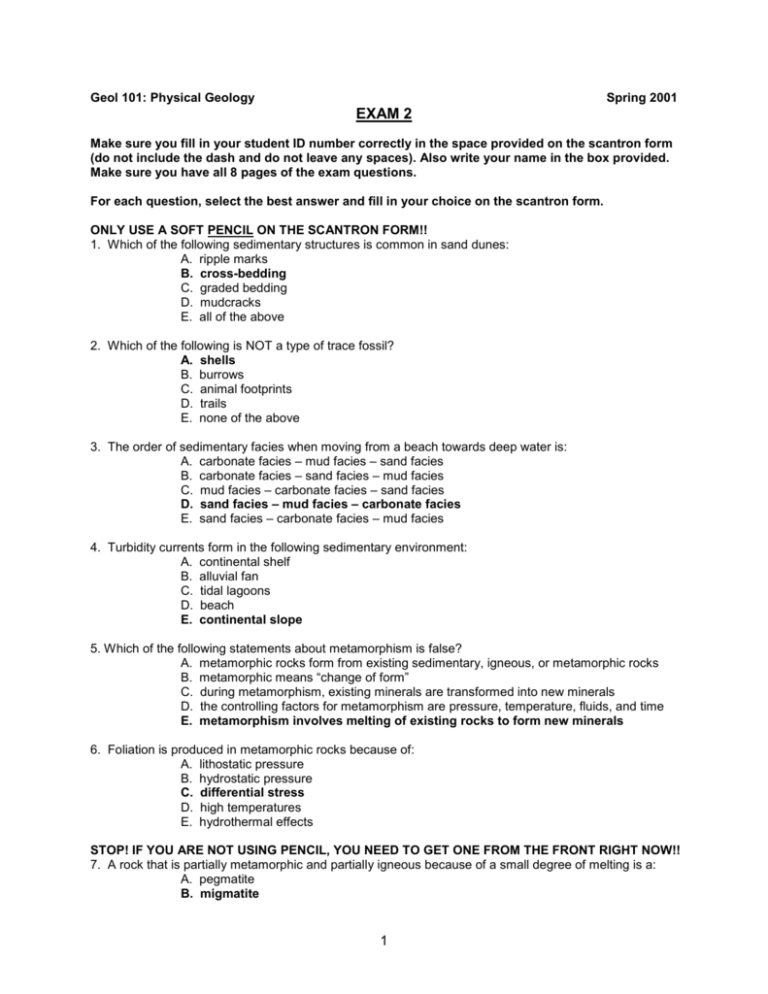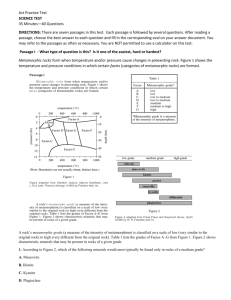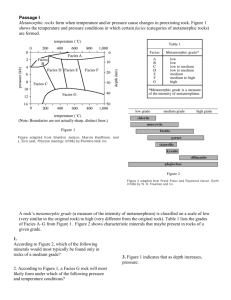Word format
advertisement

Geol 101: Physical Geology Spring 2001 EXAM 2 Make sure you fill in your student ID number correctly in the space provided on the scantron form (do not include the dash and do not leave any spaces). Also write your name in the box provided. Make sure you have all 8 pages of the exam questions. For each question, select the best answer and fill in your choice on the scantron form. ONLY USE A SOFT PENCIL ON THE SCANTRON FORM!! 1. Which of the following sedimentary structures is common in sand dunes: A. ripple marks B. cross-bedding C. graded bedding D. mudcracks E. all of the above 2. Which of the following is NOT a type of trace fossil? A. shells B. burrows C. animal footprints D. trails E. none of the above 3. The order of sedimentary facies when moving from a beach towards deep water is: A. carbonate facies – mud facies – sand facies B. carbonate facies – sand facies – mud facies C. mud facies – carbonate facies – sand facies D. sand facies – mud facies – carbonate facies E. sand facies – carbonate facies – mud facies 4. Turbidity currents form in the following sedimentary environment: A. continental shelf B. alluvial fan C. tidal lagoons D. beach E. continental slope 5. Which of the following statements about metamorphism is false? A. metamorphic rocks form from existing sedimentary, igneous, or metamorphic rocks B. metamorphic means “change of form” C. during metamorphism, existing minerals are transformed into new minerals D. the controlling factors for metamorphism are pressure, temperature, fluids, and time E. metamorphism involves melting of existing rocks to form new minerals 6. Foliation is produced in metamorphic rocks because of: A. lithostatic pressure B. hydrostatic pressure C. differential stress D. high temperatures E. hydrothermal effects STOP! IF YOU ARE NOT USING PENCIL, YOU NEED TO GET ONE FROM THE FRONT RIGHT NOW!! 7. A rock that is partially metamorphic and partially igneous because of a small degree of melting is a: A. pegmatite B. migmatite 1 C. magmatite D. magnetite E. dogmatite 8. An example of a hydrous mineral in a metamorphic rock is: A. quartz B. felsdpar C. pyroxene D. garnet E. amphibole 9. Which of the following metamorphic rock types does not fall into the same category as the others? A. marble B. gneiss C. phyllite D. slate E. schist 10. An aureole is associated with the following type of metamorphism: A. dynamic metamorphism B. contact metamorphism C. burial metamorphism D. regional metamorphism E. aureoles are not metamorphic features 11. Which of the following statements is true about the transition from one metamorphic grade to another? A. a new index mineral appears in the rock B. the mineral assemblage changes C. an isograd is crossed D. metamorphic grade decreases with increasing distance away from an igneous intrusion E. all of the above are true 12. Which of the following is not a real metamorphic facies? A. greenschist B. amphibolite C. diagenesis D. blueschist E. eclogite 13. The relative ages or order of layers of rocks is called the: A. absolute age B. principal of original horizontality C. sequential bedding D. radiometric age E. chronological sequence 14. If we see a layer of sedimentary rock that has an igneous dike through it as well as a joint that cuts through both the bed and the dike, we can use the principle of cross-cutting relationships to infer: A. the bed formed first, then the igneous dike, then the joint B. the bed formed first, then the joint, then the igneous dike C. the igneous dike formed first, then the bed, then the joint D. the igneous dike formed first, then the joint, then the bed 2 E. no age sequence can be inferred from this information 15. If there is a break in time during the deposition of rock units, this will result in the development of a/an: A. fault B. sill C. conformity D. unconformity E. none of the above 16. The technique of using fossil assemblages to determine that two rock units in different locations formed during the same period of geologic time is called: A. evolution B. correlation C. bioanalysis D. paleontology E. stratigraphy 17. The correct order of geologic time divisions, from longest to shortest, is: A. epochs, periods, eras, eons B. eras, eons, periods, epochs C. eons, eras, periods, epochs D. periods, eras, eons, epochs E. periods, epochs, eras, eons 18. The Hadean, Archean, and Proterozoic eons are collectively called the: A. Phanerozoic B. Mesozoic C. Cambrian D. Precambrian E. age of Aquarius 19. We currently live in the: A. Holocene Epoch B. Quaternary Period C. Cenozoic Era D. Phanerozoic Eon E. all of the above 20. The approximate age of the Earth determined from radiometric dating is: A. 4.5 billion years B. 4.0 billion years C. 4.5 million years D. 4.0 million years E. 4500 years 21. Isotopes of an element have: A. identical nuclei B. the same number of neutrons but different numbers of protons C. the same number of protons but different numbers of neutrons D. the same mass number but different atomic numbers E. none of the above 22. If we measure the relative amounts of parent and daughter isotopes in a rock, we can determine the absolute age if we also know: 3 A. B. C. D. E. the half-life and the original amount of parent isotope the half-life and the decay rate the decay rate and the original amount of the isotope the half-life and the actual amount of daughter isotope the decay rate and the actual amount of daughter isotope 23. Radioactive decay is characterized by: A. alpha emission B. beta emission C. gamma rays D. heat E. all of the above 24. If a magnetic reversal occurred on Earth today, it would result in new rocks exhibiting: A. remanent magnetism B. paleomagnetism C. reverse polarity D. normal polarity E. no magnetic signature 25. Any storage or transportation system in the hydrologic cycle is called a/an: A. reservoir B. aquifer C. aquiclude D. river E. hydrosphere 26. Which of the following processes does not belong in the same category as the others: A. precipitation B. condensation C. dissolution D. evaporation E. infiltration 27. The residence time of water molecules in the atmosphere is: A. thousands of years B. tens of years C. a few weeks D. a few days E. a few hours 28. Which of the following does not affect channel flow characteristics: A. gradient B. cross-sectional area of the channel C. water velocity D. water temperature E. channel discharge 29. The three types of stream load are: A. bed load, saltation load, and suspended load B. bed load, suspended load, and dissolved load C. bed load, suspended load, and precipitated load D. cobbles, sand, and silt 4 E. sand, silt, and clay 30. In a meandering channel, the outside of a river bend has a/an _______________ whereas the inside of a river bend has a/an __________________. A. oxbow lake; point bar B. incised meander; alluvium C. point bar; cut bank D. cut bank; point bar E. vertical accretion; lateral accretion 31. We can use the word “anastomosing” to describe channel flow patterns in: A. meandering channels B. braided channels C. estuaries D. turbidity currents E. none of the above 32. Distributaries can only be found in: A. meandering channels B. braided channels C. alluvial fans D. floodplains E. deltas 33. Drainage basins are separated from each other by: A. drainage divides B. continental divides C. sub-basins D. both A and B above E. all of the above 34. The drainage pattern caused by rivers flowing along parallel valleys separated by hills or ridges is: A. dendritic B. rectangular C. trellis D. radial E. deranged 35. Which of the following features is not a type of base level along a river: A. sea level B. lakes C. dams D. waterfalls E. all of the above are types of base levels 36. The occurrence of (1) __________________ can result in (2) ______________________. A. (1) ultimate base level drop; (2) incised meanders B. (1) headward erosion; (2) stream piracy C. (1) downcutting; (2) gorge development D. (1) tectonic uplift of the land; (2) stream terraces E. all of the above 5 37. Precipitation at the Earth’s surface (1) _________ into regolith, then (2) __________ downwards through the (3) ___________ to the (4) ____________. A. (1) percolates (2) infiltrates (3) zone of aeration (4) saturated zone B. (1) infiltrates (2) percolates (3) vadose zone (4) water table C. (1) transpires (2) percolates (3) saturated zone (4) water table D. (1) evaporates (2) percolates (3) unsaturated zone (4) saturated zone E. (1) percolates (2) transpires (3) water table (4) head gradient 38. The ease with which groundwater moves from pore to pore in sediment is called the: A. head gradient B. infiltration capacity C. porosity D. permeability E. discharge 39. An artesian well forms when a confined aquifer is sealed by an overlying ____________: A. aquiclude B. unconfined aquifer C. water table D. recharge zone E. vadose zone 40. A well dug into an unconfined aquifer will: A. fill up with water to the level of the water table B. dry up during the year if it is not deeper than the dry season water table level C. potentially develop a cone of depression if it is overpumped D. all of the above E. none of the above 41. The salinity of the ocean is in the range: A. 33 - 37 parts per hundred B. 33 - 37 parts per thousand C. 33 - 37 parts per million D. 33 - 37 parts per billion E. 33 - 37 parts per mouthful 42. Which of the following processes does not cause a decrease in salinity of the ocean? A. rainfall B. snowfall C. river inflow D. freezing of sea ice E. marine organisms building skeletons 43. Ocean currents are driven by (1) _________ and reach a depth of about (2) ____________. A. (1) wind (2) 10m B. (1) wind (2) 100m C. (1) wind (2) 200m D. (1) waves (2) 100m E. (1) waves (2) 200m 44. When the Earth, Moon, and Sun are in alignment, gravitational forces combine to form a: A. tidal bulge B. spring tide 6 C. neap tide D. both A and B above E. both A and C above 45. In a wave, the vertical distance from the (1) _______ to the (2) _______ is called the (3) ________. A. (1) crest (2) trough (3) wave height B. (1) crest (2) trough (3) wavelength C. (1) crest (2) trough (3) wave period D. (1) wave base (2) crest (3) wave height E. (1) wave base (2) trough (3) wave height 46. Longshore currents are caused by: A. wind blowing perpendicular to a coastline B. waves hitting the shoreline with wave crests parallel to the shoreline C. waves hitting the shoreline at an oblique angle D. the wave base hitting the sea floor E. variations in salinity and temperature 47. The process of longshore drift can cause a __________ to partially block a river mouth. A. baymouth bar B. barrier island C. tombolo D. pocket beach E. recurved spit 48. In which of the following regions in the US have barrier islands developed? A. Gulf Coast of Texas B. Outer Banks of North Carolina C. California coastline D. both A and B above E. all of the above 49. Which of the following features does not belong in the same category as the others? A. sea cliffs B. wave-cut platforms C. tombolos D. sea arches E. sea stacks 50. Sea level drop during an ice age causes a/an (1) ___________ coastline; tectonic uplift of the land causes a/an (2) ___________ coastline. A. (1) emergent (2) submergent B. (1) submergent (2) emergent C. (1) submergent (2) submergent D. (1) emergent (2) emergent E. none of the above BONUS QUESTIONS 51. An example of a stream-dominated delta is the: A. Mississippi 7 B. C. D. E. Nile Amazon Ganges Columbia 52. Which of the following can cause a change in ultimate base level: A. ice ages B. tectonic uplift C. isostatic rebound D. changes in the size of ocean basins due to movement of tectonic plates E. all of the above 53. Which of the following features is not associated with karst topography? A. disappearing streams B. tower karst C. regular drainage patterns D. sinkholes E. stalactites and stalagmites 54. The M6.8 earthquake in western Washington last month… A. was the only large earthquake ever to hit this region B. occurred deep in the subducting Juan de Fuca plate C. was the largest magnitude earthquake that is possible in this region D. was a very shallow earthquake E. none of the above 55. Camels only sit down carefully- perhaps their joints creak. Which of the following is true? A. the Jurassic comes after the Cretaceous B. the Cambrian comes after the Permian C. the Ordovician comes after the Silurian D. the Triassic comes before the Jurassic E. the Devonian comes before the Cambrian 8





